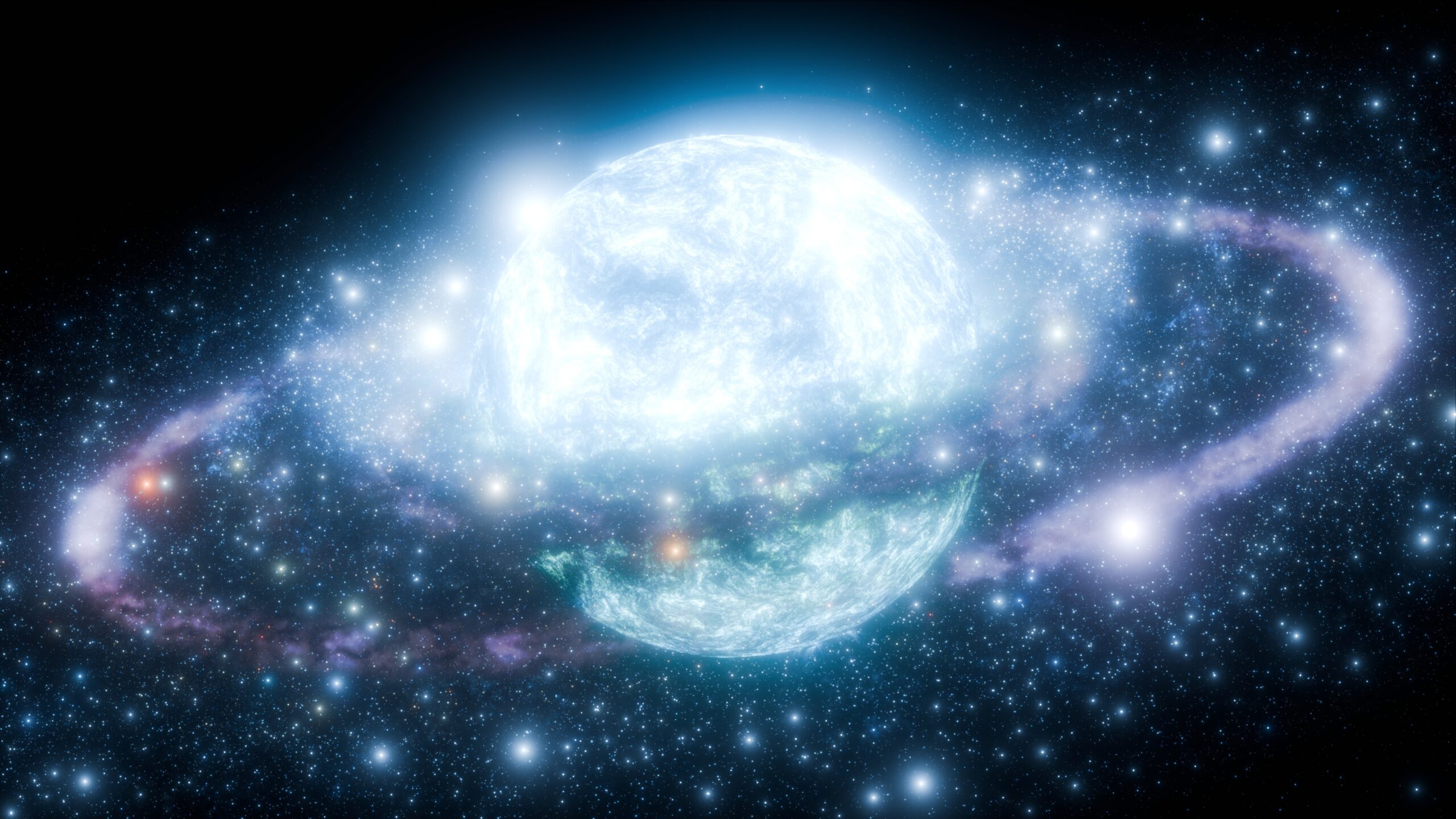NASA Found A Diamond In Space That Is 5 Times Bigger Than Earth!

A discovery was made in the depths of space that challenges what we thought planets could be.
Astronomers detected a dense object orbiting a collapsed star thousands of light-years away. It doesn’t reflect sunlight or support life. It doesn’t resemble any known world in our solar system. And yet, it exists—quietly circling its parent star with a precision that defies chaos.
At first glance, it looks like a planet. But the deeper scientists looked, the stranger it became. Its mass is enormous. Its size is compact. And based on its composition, it is likely made almost entirely of crystallized carbon—what we know on Earth as diamond.
This object does not orbit a typical star. Its companion is something far more extreme, the remnant of a supernova that still spins faster than almost anything known in the universe. Together, the two form a system that raises questions about destruction, survival, and what remains after everything else has been stripped away.
What follows is not just a scientific account—it’s a reflection on resilience, transformation, and the unexpected ways the universe reveals its beauty.
The Star That Refused to Die Quietly

Long before a diamond planet took shape, there was a star.
It lived in a binary system, locked in orbit with a companion. For millions of years, it followed the familiar path of stellar life—burning hydrogen, radiating light, and holding itself together through the balance of fusion and gravity. But like all stars, it eventually reached its limit.
Its final act was explosive. The core collapsed, and the outer layers were ejected into space in a supernova. What remained was not silence, but something more powerful: a neutron star.
Neutron stars are among the most extreme objects in existence. They contain more mass than our Sun, but are compressed into a sphere just 20 kilometers across. At that scale, a single teaspoon of its material would weigh billions of tons. Density isn’t an exaggeration here—it’s physics taken to its limit.
But the transformation did not stop there.
Over time, this neutron star began to spin faster. Much faster. With help from its companion, matter flowed toward it, accelerating its rotation to unimaginable speed. It became what astronomers call a millisecond pulsar—a kind of cosmic lighthouse that emits beams of radiation with perfect regularity.

PSR J1719-1438 is one of those pulsars. It rotates once every 5.4 milliseconds—more than 10,000 times per minute. That speed is not sustained by inertia alone. It’s a legacy of gravitational pull and mass transfer, a dance between two dying stars that rewrote both of their destinies.
Pulsars like this are rare. Millisecond pulsars, even more so. They are signs of something violent, something ancient. Their precision tells scientists that even chaos has rhythm when observed at the right scale.
And in this case, that rhythm pointed toward something else. A second object. A presence, smaller and darker, that was tugging gently at the pulsar’s light. At first, it was barely detectable—just a slight modulation in the signal. But with every rotation, the evidence became clearer.
There was something orbiting PSR J1719-1438. Not a star. Not another neutron core.
Something smaller. Stranger. Denser than anything a planet should be.
The Planet That Shouldn’t Exist

What the pulsar revealed was unexpected.
Orbiting PSR J1719-1438 was an object too small to be a star, yet too massive and dense to resemble any planet we’ve ever seen. It completed a full orbit in just over two hours, circling its host star at a distance of around 600,000 kilometers—less than the radius of our own Sun.
The numbers didn’t add up. Its diameter was estimated at 60,000 kilometers, roughly five times that of Earth. Its mass, nearly identical to Jupiter’s. But this object was far smaller than Jupiter in size. That kind of mass packed into that little space meant only one thing: extreme density.
Researchers at Swinburne University of Technology in Australia, led by Professor Matthew Bailes, began investigating further. The data was consistent. This companion wasn’t a gas giant. It wasn’t a rocky world either. Its density was calculated to be around 23 grams per cubic centimeter—far beyond any naturally occurring planet in our solar system. For comparison, Earth’s average density is just over 5 grams per cubic centimeter.
The conclusion, though extraordinary, was backed by the physics: the object was made almost entirely of carbon and oxygen. Under the intense pressure of its own gravity, much of that carbon had likely crystallized. In effect, this planet had become a massive diamond in space.
But the more scientists studied the object, the clearer its origin became. This was never an ordinary planet. It was once a star.
Specifically, it had been a white dwarf—the dense, cooling remnant left behind after a star exhausts its nuclear fuel. In its final stages, as the pulsar’s gravity pulled on it, it lost more than 99.9 percent of its mass. The outer layers were stripped away. The heat and fusion faded. What was left was a core composed of carbon, under pressure high enough to solidify into a crystalline structure.
It had become something planetary in size, but stellar in history.
Most millisecond pulsars are found with white dwarf companions. In this case, the white dwarf was stripped so completely that it crossed the threshold—no longer a star, not quite a typical planet. It occupied a strange space in between. A boundary object. The term “planet” applies, but only in the loosest sense. It does not support life. It does not orbit a sun. It carries no atmosphere, no weather, no magnetic field. Just mass, gravity, and silence.
Still, it remains in orbit, locked into a two-hour cycle around a host star that itself is barely larger than a city. And yet, this planet is larger than its sun. A dead world orbiting a remnant sun, both of them survivors of violence, existing in balance that shouldn’t have been possible.
Science rarely speaks in absolutes. But astronomers are confident about this: there is no other known planet like it.
And perhaps more telling than the object itself is how it was found. Not through a telescope’s lens, but through the regular ticking of a pulsar’s signal. A tiny modulation in rhythm. A wobble in precision. Proof that even in a vacuum of darkness, the universe leaves clues for those willing to listen closely enough.
Beauty Under Pressure

A diamond that spans 60,000 kilometers is not something we were ever meant to touch. But its existence touches something in us.
PSR J1719-1438b is more than a scientific oddity. It is the result of immense pressure, relentless stripping, and survival against impossible odds. What remains is dense, hardened, and enduring. Its brilliance is not in how it shines—but in the fact that it still exists at all.
The universe didn’t shape this world with gentle hands. It began with collapse. The companion star grew old, expanded, and was pulled apart. Piece by piece, layer by layer, it lost everything that once made it burn. Over time, what remained was a carbon-rich core, so compressed that its structure likely shifted into something crystalline.
That’s what diamond is, after all—a crystal form of carbon, formed under pressure. On Earth, it takes heat and crushing force to create one. In space, the same rules apply, but on a scale that dwarfs anything we know.
And still, the result is the same. From intense force, something enduring emerges.

There’s a message there. One that doesn’t require you to understand astrophysics or the mechanics of binary star evolution. This is the kind of story that speaks to anyone who’s been through difficulty. Who’s felt like parts of themselves were stripped away. Who’s wondered what remains after everything else is gone.
What PSR J1719-1438b shows us is that beauty can be a product of pressure. Not the kind that polishes—but the kind that crushes. And yet, the outcome is not ruin. It’s resilience. Compressed, yes. Altered, absolutely. But still holding form. Still orbiting. Still present.
We’re often taught to look for beauty in perfection, in softness, in symmetry. But sometimes, beauty is density. Weight. What survives. Not what sparkles under light, but what doesn’t disintegrate in the dark.
This diamond planet doesn’t reflect light the way we expect. It doesn’t glitter. It doesn’t dazzle the eye. But it carries a story of transformation that reaches far beyond the vacuum it spins through.
And that story reminds us: pressure doesn’t always break us. Sometimes, it reveals what was always hidden inside.
Not All Planets Are Born—Some Are Forged
A planet made of diamond orbiting a collapsed star might sound like something out of fiction. But it is real, measurable, and confirmed through careful observation and data.
What makes PSR J1719-1438b remarkable isn’t just its composition—it’s how it forces us to rethink the boundaries of what a planet can be.
Traditionally, planets are considered passive companions. They orbit, reflect light, support moons, or harbor atmospheres. But this one doesn’t fit the mold. It began not as a cold rock, but as a star—a nuclear furnace with its own path through cosmic time. Its transformation challenges everything we expect from the life cycle of celestial bodies.
That disruption is part of what makes this discovery so meaningful. Science thrives on outliers, on the exceptions that force revision. When astronomers tracked the tiny disturbances in the radio pulses from the millisecond pulsar, they weren’t looking for a diamond planet. They were following anomalies. Small irregularities that didn’t make sense. And yet, those details led them to one of the densest planets ever found.
The entire system—pulsar and planet together—could fit inside the radius of our Sun. That scale puts into perspective how compact and intense this pairing really is. Despite its modest size, it carries enormous scientific weight.

Pulsars themselves are still not fully understood. These objects push physics to its limits. The gravitational forces, magnetic fields, and densities involved can’t be recreated in any lab on Earth. Each new system discovered gives researchers more insight into how stars evolve, how matter behaves under extreme conditions, and how binary systems interact over billions of years.
But beyond the numbers, there’s a larger reflection worth making.
The discovery of PSR J1719-1438b reminds us that the universe is not static. It is not neat or predictable. The things we classify—stars, planets, remnants, debris—don’t always stay in their lanes. The cosmos is built on transformation. Objects collapse and return as something else entirely. What looks like an end may be part of a process we don’t fully see.
There’s humility in that.
For all our equations and instruments, the universe continues to surprise us. Even after decades of mapping the sky, we find ourselves standing in awe of something we didn’t know was possible.
And sometimes, the smallest shifts—the slight delay in a pulse, the tiniest wobble in a signal—lead us to the most profound truths.
We’re All Made of Stars—Some Just Shine Differently

PSR J1719-1438b is not just an unusual object in the cosmos—it’s a challenge to our assumptions. Formed from the remnants of a dead star, it now exists as one of the densest known planets, likely made almost entirely of diamond. Its orbit around a collapsed, rapidly spinning neutron star is a reminder that the universe doesn’t always follow our definitions. Stars can become planets. Violence can create order. Collapse can leave behind something rare.
What gives this story its weight is not just the science—it’s the reflection it invites. This world didn’t survive by staying intact. It endured by letting go. Over 99.9 percent of its original mass is gone, stripped away by gravitational force and radiation. And yet, what remained became something stronger. Something new. That is not just a story about matter—it’s a story about meaning. We all face pressures that threaten to dismantle us. But sometimes, what’s left after the breaking is not emptiness, but something harder, clearer, more resilient.
We may never visit this planet. We may never see it through a telescope. But its existence is enough. Enough to remind us that we, too, are made from stars. Not everything that endures shines with visible light. Some things shine because they refuse to disappear. Because even after losing almost everything, they still hold their place in the orbit. And maybe that’s what survival really is.
Featured Image Source: Pixabay
Source:
- Bailes, M., Bates, S. D., Bhalerao, V., Bhat, N. D. R., Burgay, M., Burke-Spolaor, S., D’Amico, N., Johnston, S., Keith, M. J., Kramer, M., Kulkarni, S. R., Levin, L., Lyne, A. G., Milia, S., Possenti, A., Spitler, L., Stappers, B., & Van Straten, W. (2011). Transformation of a Star into a Planet in a Millisecond Pulsar Binary. Science, 333(6050), 1717–1720. https://doi.org/10.1126/science.1208890
Loading...
Related Content
 When Science Shows Our Bones Can Rise Again
When Science Shows Our Bones Can Rise AgainBy Prince Ea





